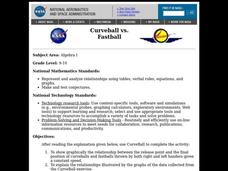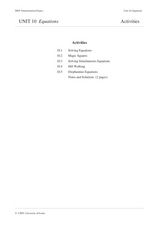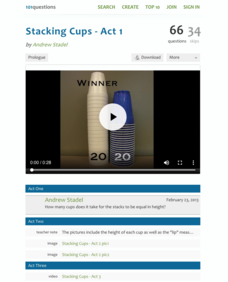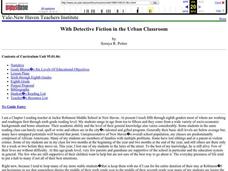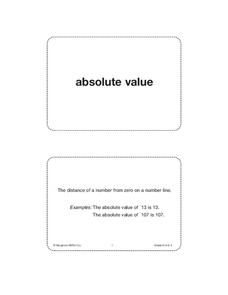Curated OER
Building Patterns Incrementally
Students study the recurrence rules for patterns where the increase from one term to the next is not constant. They look for the recurrence rule on their own. They copy the pattern and create the next element, continue the pattern with...
Curated OER
Multivariable Calculus: Bonus Quiz 6
In this gradient operator and gradient fields worksheet, students determine if two vectors are gradient fields. They solve for the appropriate scalar functions of a vector variable. Students show that the gravitation al force exerted on...
Curated OER
Solutions of Initial Value Problems
In this initial value worksheet, students explore the best methods to solve rate problems. Students differentiate functions to check the initial value of problems. This two-page worksheet contains approximately ten multi-step problems.
Curated OER
Patterns, Relations, and Functions: Lesson 3: Numerical Patterns
Fourth graders extend and continue numerical patterns using function or input/output machines. They finish the increasing patterns using input/output tables, and generalize the rules that apply to the pattern. They complete the...
Curated OER
Sportsperson of the Day
Students follow the classroom and game/activities rules. They demonstrate responsibility by wearing tennis shoes to class, assisting others, taking care of equipment, helping clean-up, show respect and kindness to others during class time.
Curated OER
Learning Lesson: Measure the Pressure -- The "Wet" Barometer
Students use simple objects to create their own barometer. They have five days to build it and ten days to observe and collect data. They examine thunderstorm safety tips to end the lesson.
Curated OER
Curveball vs. Fastball
Students graph the relationship between the release point and the final position of curveballs and fastballs thrown by both right and left handers given a constant speed, and explain the relationships illustrated by the graphs of data.
Curated OER
A Train of Shapes
Students review the names of the shapes by holding up each one and place the shapes on the work mat so that all children can see them. They then review attributes by posing different questions.
Curated OER
Magic Squares, Simultaneous Equations, Hill Walking, and Diophantine Equations
In this solving equations learning exercise, 9th graders solve and complete 21 various types of problems. First, they use the method shown to find the value of xin each equation. Then, students use an algebraic approach to solve the...
Curated OER
Interpreting the Evidence
Students find out about the social changes that caused the collapse of important ancient civilizations in Central America, Mesopotamia, the southwestern United States, and western Africa.
Curated OER
Improving Speaking Skills in the Language Classroom
How can you create an "English-free" classroom for your foreign language learners? This year, use some of these strategies to maximize your students' opportunity to communicate in the language.
Curated OER
Healthy Relationships
Teens, dating, relationships, breaking up, what's appropriate dating behavior? Go through this PowerPoint presentation and discuss all of these things and more. Too often, teens are not sure what's appropriate and what's inappropriate...
Curated OER
Scientific Notation
Review conversion of decimal numbers into SN form with these examples of common astronomical applications and quantities. Young learners rewrite those numbers with scientific notation and with the correct units. The answers are available...
Curated OER
Logistic Growth Model, Explicit Version
Via the concrete setting of estimating the population of the US, your algebra learners are introduced to a logistic growth model. Comparing and contrasting logistic, exponential, linear and quadratic models, to see which fits the data...
Inside Mathematics
Conference Tables
Pupils analyze a pattern of conference tables to determine the number of tables needed and the number of people that can be seated for a given size. Individuals develop general formulas for the two growing number patterns and...
Noyce Foundation
Truffles
Knowing how to scale a recipe is an important skill. Young mathematicians determine the amount of ingredients they need to make a certain number of truffles when given a recipe. They determine a relationship between ingredients given a...
101 Questions
Stacking Cups
Facilitate an understanding of equality using a modeling task. After watching different-sized cups being stacked, learners use their math skills to determine when the height of each cup tower will be the same. Meant as an introduction to...
Curated OER
With Detective Fiction in the Urban Classroom
This abstract for an instructional unit using three-minute mysteries, stories by Sir Arthur Canon Doyle, and Edgar Allan Poe includes a short history of detective fiction, sample plans, and suggestions for exercises and activities...
Curated OER
Worksheet 12: Functions
In this math worksheet, students are given 7 problems in which they differentiate, figure rate of change, determine value, and prove formulas.
Curated OER
The Settlement of New England
A thorough exploration of the Puritan Migration and settlement of Plymouth, this presentation is sure to engage your young historians with its clear maps and historical documents. The presentation differentiates the philosophies of...
Curated OER
Bill of Rights
US history classes explore constitutional rights as they relate to court cases involving teens. Your class must already be familiar with the Bill of Rights before beginning this series of exercises. In preparation for a debate-style...
KOG Ranger Program
Leading Causes of Wildfires in Oregon
You've heard of "wildfire season," but what types of weather and conditions lead to increased wildfires? Young firefighters learn about common sources of wildfires, safe ways to clear debris near their homes, and the most effective ways...
Houghton Mifflin Harcourt
Unit 4 Math Vocabulary Cards (Grade 6)
Reinforce math vocabulary with a set of flash cards. Forty-eight cards offer boldly printed words, and their corresponding definition alongside an example with labels. Terms include absolute value, inverse operations, slope, and more!
EngageNY
Dividing by (x – a) and (x + a)
Patterns in math emerge from seemingly random places. Learners explore the patterns for factoring the sum and differences of perfect roots. Analyzing these patterns helps young mathematicians develop the polynomial identities.






